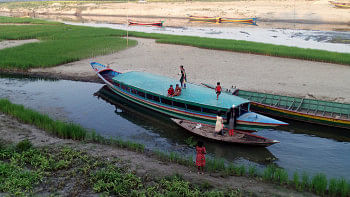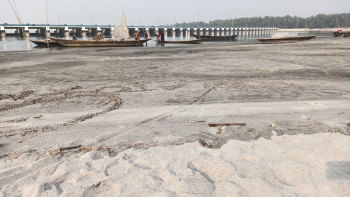Living with the river or fighting against it?

As recent reports and editorials in this newspaper have conveyed, the scale of river erosion in eight northwestern districts, particularly Kurigram and Lalmonirhat, is very alarming. The heart-breaking stories of people losing their homes and hearth, their sources of livelihood, and all their belongings, are all too common in Bangladesh. As a result, close to one million people are internally displaced annually due to river erosion in the country.
As a delta country, Bangladesh is largely formed by river deposition, erosion, and redeposition. Major river systems such as the Teesta, Brahmaputra-Jamuna, Padma, and Meghna, together with their larger tributaries, are continually eating up land from one bank and depositing silt to the other. As Kazi Nazrul Islam's verse goes, "E kul bhange, o kul gorey, eito nodir khela" ("Here a bank breaks, there another emerges. Such is the play of rivers"). In the process, alluvial chars of various sizes also emerge as agricultural frontiers, which are populated and often wither away again. This erosion and accretion of land is a characteristic feature of the active river systems of Bangladesh.
The annual flooding and the massive flow of water from upstream Himalayas cause extensive bankline erosion and channel migration, associated with the siltation of river beds as chars, further amplifying flood risks and erosion. This also has macro and micro impacts on the rural population and land-based economy of the country. The earliest response by the government to this "twin" problem of flooding and erosion can be traced back to the measures recommended by the United Nations Krug Mission in 1956, following the massive floods in East Pakistan (now Bangladesh) in 1954. The Krug Mission Report stressed the need for the construction of high embankments to confine the waters of major rivers within their main channels and to cordon off large areas from flooding.
A long-term master plan was also prepared by the East Pakistan Water and Power Development Authority (EPWAPDA) – the predecessor of the Bangladesh Water Development Board (BWDB) – focusing on large-scale engineering construction and interventions for flood control and bank protection efforts such as building embankments, groins, dams, and polders to provide protection and minimise human and material losses.
Many experts now believe that the Krug Mission set off the process of water development in a wrong direction. There was little attention to environmental and ecological aspects and to the need to understand local cultural and indigenous practices related to flood, land use, land rights, and socioeconomic processes in the river delta. In fact, it is neither possible nor desirable to eliminate flooding completely, for floods are intricately linked to the very survival of people in this delta country. Rice and fish – staples in Bangladeshi diet – require a tremendous amount of floodwater to grow and flourish.
Even today, the BWDB approach to river management tends to remain totally monistic, with a single-minded preference for protective efforts. The multi-channel Jamuna River stabilisation programme is one example of this, which seeks to narrow down the width into a single- or double-channel planform, combined with dredging for a navigational channel, protection of the existing bankline against erosion, and boost of economic growth, as envisioned in the Bangladesh Delta Plan 2100. If the corridors of major rivers were to be converted into a single channel, an estimated 50,000 hectares of new land would be reclaimed for potential use for various development interventions, including for the establishment of river ports and industrial/trade centres such as economic processing zones (EPZs).
Long-term river stabilisation is an ambitious yet uncertain course of action. Such a plan should be based on a broader and clearer understanding of the vital physical, ecological, economic, social, and environmental vulnerabilities of floodplain users, particularly keeping in mind the rights of char inhabitants over the newly reclaimed land, their livelihoods, kinship, residence patterns, and resettlement. Currently, there are an estimated six million char dwellers, with or without land rights, living on the chars from Chilmari to Sirajganj. Therefore, a more holistic approach to the issues of flooding and erosion is necessary – one that would take cognisance of the complex interactions of all aspects of how people have traditionally organised, produced, and survived within physical constraints. Each of these aspects is critical to understanding the river management problem from a "hydrosociality" perspective, and not just an engineering perspective.
Any river stabilisation programme of a large scale must be based on national dialogues and engagements with stakeholders in char areas.
In the past, the BWDB has taken many structural measures to control and/or regulate the Jamuna River. But the mighty Jamuna and the sheer magnitude of the monsoon floods preclude almost all types of engineering work as a means to halt erosion and prevent flooding. The short-lived and limited utility of some of the physical infrastructures built so far have led to widespread doubts about the wisdom of this approach. Experts are also concerned regarding the long-term impacts of river stabilisation if implemented without careful consideration of the transboundary nature of the country's river systems, given that Bangladesh is located at the lower reaches. If the width of the lower stream of the Jamuna and other rivers – which originate upstream in Tibet, China, and India – are narrowed down to one or two channels, it could spell disaster for the normal flow of water and seriously harm the rich local biodiversity.
Any river stabilisation programme of a large scale must be based on national dialogues and engagements with stakeholders in char areas. Since there appear to be no practical means of stopping erosion (despite existing embankments and protective efforts), the solution lies in developing socioeconomic measures (such as improving warning systems, increasing preparedness for loss reduction, recovery, resettlement, livelihoods, formulation of new land laws for char use and ownership, etc) to mitigate the impacts of erosion events, rather than preventing erosion itself. In other words, it is necessary to live with the river rather than fight against it.
Of course, some interventions and limited protection work for major towns, ports and other important establishments will always be necessary, along with some form of stabilisation in selected sections of major rivers. However, a full-scale programme for the stabilisation of these rivers may be unnecessary, as they would affect human populations and their agricultural needs, besides impacting essential ecological processes and biological diversity. It is possible to plan alternatives and create adaptive pathways to manage the rivers in Bangladesh, which would also be in line with the Delta Plan 2100. There is a greater need for understanding life in the delta before we transform it. Unfortunately, this seems to be lacking in Bangladesh as of now.
Dr Mohammad Zaman has carried out extensive ethnographic research on flood, erosion disasters, and displacement in the Brahmaputra-Jamuna floodplain. His recently edited book (co-edited by Mustafa Alam) is titled 'Living on the Edge: Char Dwellers in Bangladesh.'


 For all latest news, follow The Daily Star's Google News channel.
For all latest news, follow The Daily Star's Google News channel. 











Comments